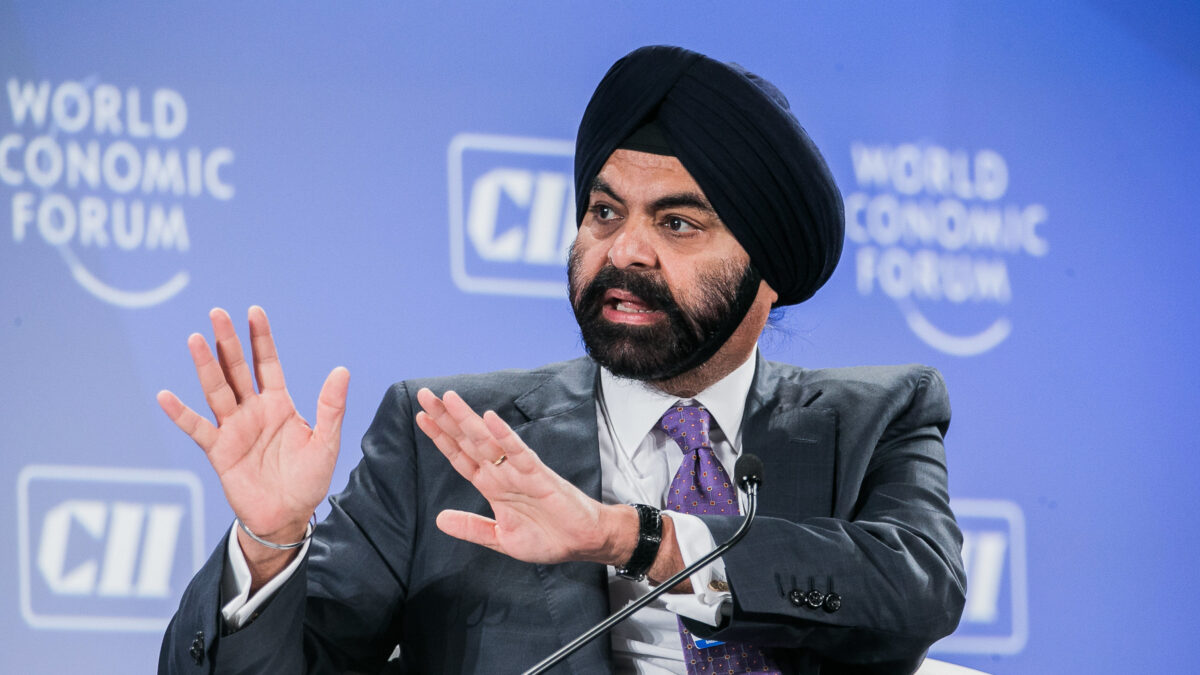After a year at the helm, Ajay Banga has shifted focus, but policy on fossil fuel, industrial ag, and climate debt draws fire
It has been over a year since Ajay Banga took the helm of the World Bank, pledging to ramp up its climate initiatives. But how well has he delivered on the promises he made when he took on the role?
U.S. President Biden nominated Banga to lead the global development finance institution, for which the United States is the largest shareholder. The Indian-born and educated U.S. citizen replaced David Malpass, who gained the position during the Trump administration. Calls for Malpass to step down reached a crescendo in 2023 when he appeared to question the connection between climate change and fossil fuels.
Soon after becoming president of the World Bank, Banga introduced a new vision statement for the bank which included a focus on sustainability and reducing the impact of climate change in order to “create a world free of poverty on a livable planet.”
During the COP 28 meetings in December, he committed to allocating 45% of the lender’s annual financing to climate by 2025, 10% more than the previous year. Under Banga’s leadership, the World Bank has introduced programs to slash methane emissions and help developing countries better respond to crises, as well as broaden its climate resilient debt pause clauses to include all existing loans to 45 countries that are hit by natural disasters.
The lender has also introduced a corporate scorecard to capture the outcomes of its investments, including greenhouse gas emissions that have been avoided and the amount of renewable energy generated through its programs.
However, some environmental and civil society groups are not happy with the World Bank’s progress and the lender’s continued investment in fossil fuels and industrial livestock under Banga.
“Banga should walk the talk by cleaning up the World Bank’s own act and encouraging other financial actors, which it has influence over, to follow suit.”
“Banga should walk the talk by cleaning up the World Bank’s own act and encouraging other financial actors, which it has influence over, to follow suit,” Erich Pica, president of Friends of the Earth, said during an online press conference.
In 2023, the bank allocated 0.2% to fossil fuel investments — US$170 million out of a total US$122 billion — which Banga told a panel “was for natural gas as part of a transition.”
But some dispute those numbers, saying the World Bank’s fossil fuel investments are much higher. According to an analysis by Big Shift Data, a global coalition of think tanks, the World Bank may have invested as much as US$885 million in the 2022 fiscal year, and at least US$194 million in 2023.
The World Bank said its goal is to end fossil fuel use, including gas, but that it would need to be done while helping developing countries gain access to the electricity needed to grow. The transition to clean energy will likely take time, and the bank argues that this means continuing to use some natural gas.
According to the World Bank, changes in their operations and climate efforts will, over time, lead to more renewable energy and accelerate the transition to low-carbon development and climate-resilient growth.
Critics have also challenged the World Bank’s failure to address industrial agriculture, which is a significant driver of methane emissions. While the lender has acknowledged the impact of industrial livestock, Pica said it is not enough as “the World Bank has failed to address emissions from its own investments in industrial livestock.”
He also criticized the World Bank for not requiring clients in this sector to report Scope 1, 2, and 3 emissions, set reduction targets or remove deforestation from supply chains.
The World Bank said it was working to reduce methane emissions across all its operations, from country engagements to its lending portfolios. Last year, the lender announced plans to launch 15 national programs to reduce methane emissions in livestock, rice production and waste management, which it says will slash 10 million tons of methane.
“This lack of transparency erodes trust and undermines the bank’s credibility as a leader in climate finance.”
Kate Donald, head of the DC office at Oxfam International, criticized the World Bank for not being transparent around climate finance and questioned Banga’s claims that climate finance would make up 45% of lending by 2025.
“This lack of transparency erodes trust and undermines the bank’s credibility as a leader in climate finance,” she said.
Reports from Oxfam have found discrepancies in the World Bank’s climate finance flows. The World Bank says its methodology was developed with other multilateral development banks and is in the process of developing new metrics to capture outcomes more effectively, which will be aligned with its corporate scorecard.
Niranjali Amerasinghe, executive director of ActionAid USA, said she saw no evidence that the World Bank is shifting its approach to the climate debt crisis in the global south.
As these countries are hit with more and more extreme weather events, they are in so much debt already that it is difficult for them to respond. Giving them more loans to handle the climate crisis just makes the debt situation worse.
“After one year, unfortunately we are not seeing much evidence of a genuine shift in how the bank is approaching compounding crises of debt and climate impacts in developing countries,” Amerasinghe said.
Featured photo: World Economic Forum / Benedikt von Loebell


